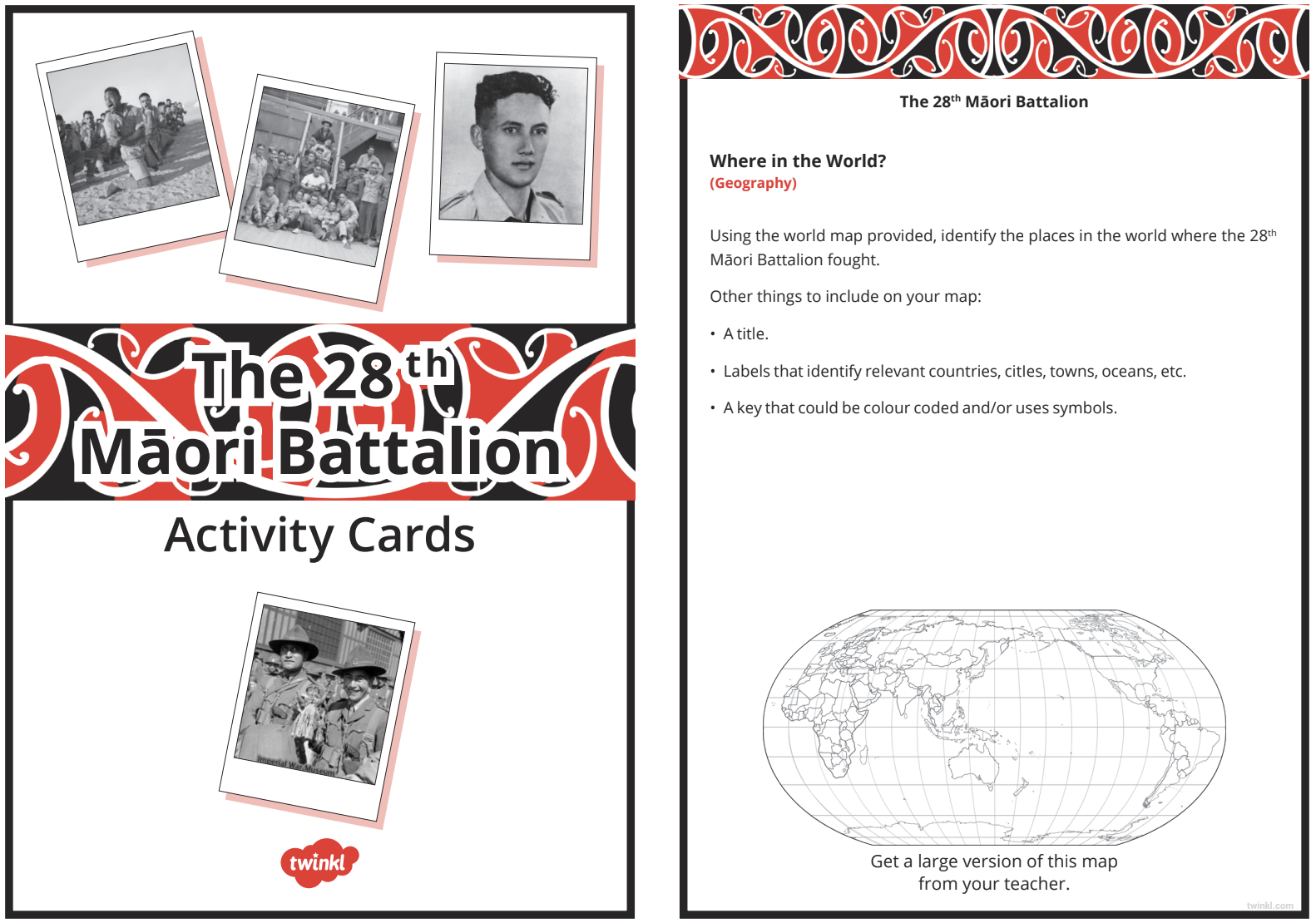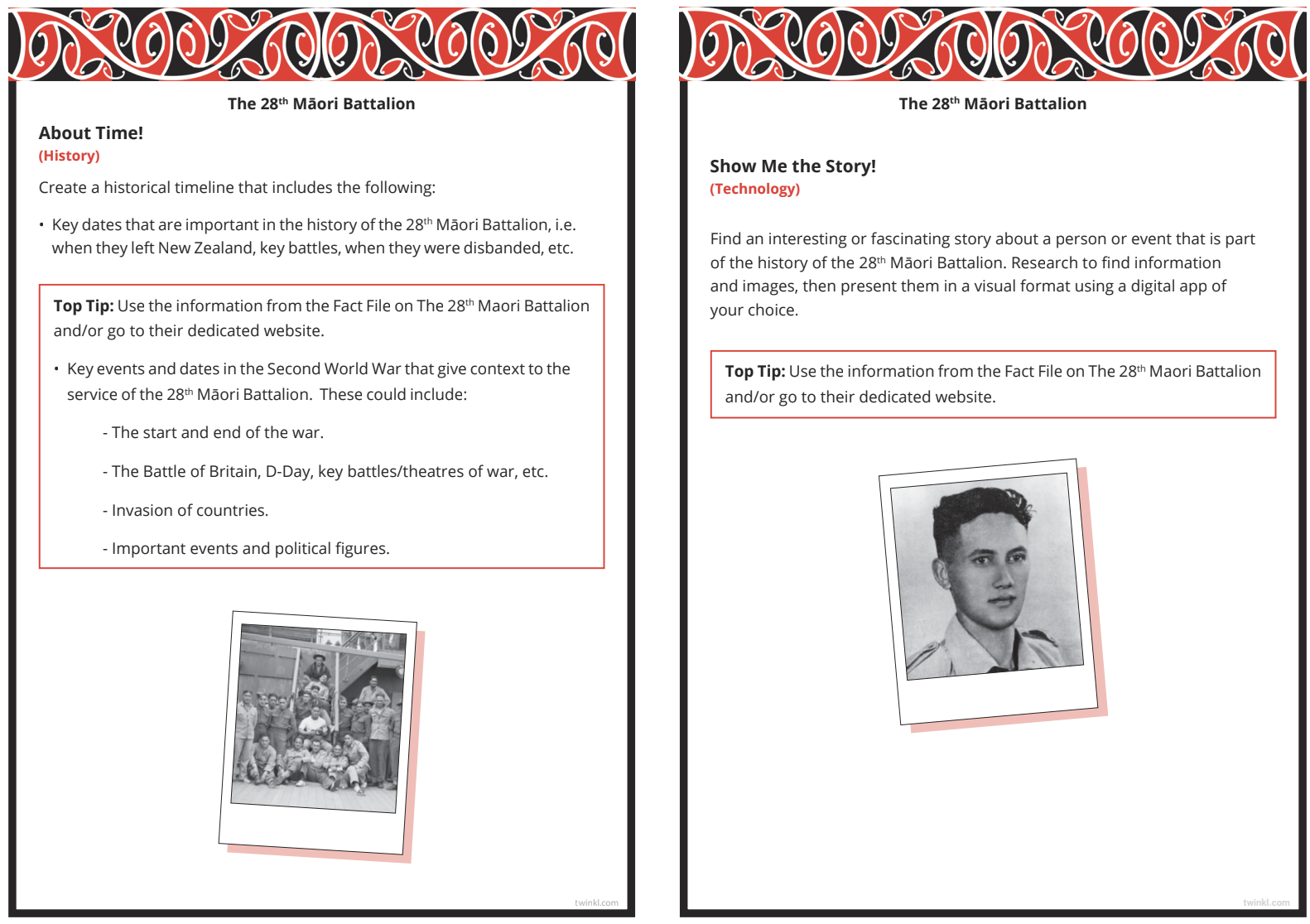20 May - 26 May
Section outline
-
Enter text here...
PLAN & DO / WHAKAMAHI learning intentions:
- We are PLANNING to understand NZ at War so that we can understand the level of participation of the Maori Battalion and NZ Women in wars.
Source Analysis


World War II: The Pacific Front
Part 1: Significant Terms: Instructions: In least one complete sentence each, describe the historical significance of the terms below in reference to the Pacific Front of World War II.
1. Isoroku Yamamoto:
2. Pearl Harbor:
3. James Doolittle:
4. Frank Fletcher:
5. Battle of Midway:
6. Hiroshima:
7. Nagasaki:
8. Hirohito:
Part 2: Short Answer: Instructions: In at least one paragraph each, answer the questions below.
1. Who was Douglas MacArthur? What impact did he have on the Pacific Front of WW II?
2. What role did J. Robert Oppenheimer and Albert Einstein have in World War II?
3. Describe what happened to Japan after they surrendered. Also, describe the aftermath of WW II and the way it impacted the world.
Use information below to complete the Source Analysis.
World War II: The Pacific Front
Japan was in the Axis Powers with Germany and Italy. President Franklin Delano Roosevelt (1882-1945) feared Japanese expansion in Asia. He tried to pursue measures to stop them. FDR gave aid to China to help them against Japan and cut off oil supplies to Japan. Angry at these actions, Japan assumed that, eventually, the USA would join the war. In a preemptive strike, Japan attacked American naval ships in Pearl Harbor in Hawaii. Over 2,000 Americans were killed. Admiral Isoroku Yamamoto (1884-1943) led the attack for Japan on December 7th, 1941.
The USA controlled the Philippines and Guam due to gaining these territories in the Spanish American War of 1898. By 1942, Japan had invaded these areas and took them from the USA. Likewise, Japan attacked the British controlled area of Hong Kong in China. They also took the Dutch East Indies. The Japanese aggressively were seeking to control all of Asia.
The Japanese were vicious toward the regions they conquered and especially toward the soldiers who resisted their occupation. This cruelty was particularly evident in the Japanese conquest of the Philippines, which was a territory of the USA. Their malice was chiefly made visible in The Bataan Death March of 1942. Tens of thousands of American and Filipino soldiers were taken as prisoners of war. The Japanese forced the soldiers to march down the Bataan Peninsula. During the march, the prisoners of war were physically beaten and abused. Thousands were also murdered during and after the march.
After Pearl Harbor, the USA joined the Allies and declared war on Japan and the Axis Powers. Their main military focus was on Hitler’s Nazi takeover of Europe. However, the USA wanted to prove they could strike back against Japan on its own mainland. On April 18th, 1942, Colonel James Doolittle (1896-1993) led an American bombing raid on Tokyo, taking out various military targets. This operation boosted the attitude of the USA because it proved to the world that Japan could be attacked in their own capital. It was called Doolittle’s Raid.
Japan had conquered various areas in the Pacific and turned next to Australia, in May of 1942. The Imperial Japanese Navy tried to take various areas in the Coral Sea, like New Guinea, as a launching pad for a full invasion of Australia. American naval fleets arrived to fight the Japanese and defend Australia.
In the Battle of the Coral Sea in 1942, Aircraft carriers played a major role in the conflict and its outcome. War Planes caused the vast majority of the damage to both the American and Japanese naval vessels. Admiral Shigeyoshi Inoue (1889-1975) led the Imperial Japanese Navy in its attempt to secure strong holds for a future Australian invasion. US Admiral Frank Fletcher (1885-1973) led a group of American and Australian forces to face off against the Japanese. The Battle of the Coral Sea was costly to both Japan and the team of American and Australia. Yet, it halted a full Japanese takeover of Australia.
In the Battle of Midway, one month after the Battle of the Coral Sea, in June of 1942, Japan sought to invade and control the island of Midway, the location of an American base. Japanese Admiral Isoroku Yamamoto (1884-1943), helped lead the attack for the Imperial Japanese Navy. Yet, American Admiral Chester Nimitz (1885-1966), resisted the attack and maintained the American strong hold. This was a massive victory for the Allies, because the Imperial Japanese Navy had to retreat. Four Japanese ships that had participated in Pearl Harbor were at Midway and were sunk by the Americans.
After the Battle of Midway, the Allies launched various offenses against Japanese strong holds in the Pacific. General Douglas MacArthur (1880-1964) led America and the Allies in these pursuits. MacArthur launched invasions to take the islands of Iwo Jima and Okinawa. In the Battle of Iwo Jima from February to March of 1945 and the Battle of Okinawa from April to June of 1945, the two islands were seized from Japan as the Allies then focused their attention to Japan’s mainland. Japan had overtaken a massive amount of the Pacific region. Yet, now, the Allies were bringing great defeats to the Japanese. In an attempt of desperation, the Japanese commanded their pilots to crash into Allied vessels. These pilots were called kamikazes. Even with these drastic measures, the Japanese could not halt the Allies progression against their nation.
What Japan did not realize was that a gargantuan secret development was taking place in the USA, code named the Manhattan Project. Led by J. Robert Oppenheimer (1904-1967), scientists built the first nuclear weapons, atom bombs. Helping them was a Jewish scientist who escaped Nazi occupied Europe, Albert Einstein (1879-1955). This was called the Manhattan Project. President Franklin Roosevelt died on April 12th, 1945 from natural causes, before the bomb was ready to use. Harry Truman (1884-1972) became President. He knew a land invasion of the mainland of Japan could cost millions of Japanese and American lives. Truman gave the command to force Japan to surrender by ordering atom bombs to be dropped on Hiroshima on August 6th, 1945 and Nagasaki on August 9th, 1945. The aircraft called the Enola Gay dropped the first atom bomb on Hiroshima. The attack was devastating instantly killing tens of thousands of Japanese citizens. It was the most powerful weapon ever used in warfare.
After the devastating atomic bomb attack, Japan surrendered. Now, Germany, Italy, and Japan, (the Axis Powers) were all defeated. General MacArthur met with Japanese leadership on the USS Missouri in Tokyo, on September 2nd, 1945, to sign the Japanese Instrument of Surrender Treaty. The Prime Minister of Japan, and mastermind of many military campaigns, Hideki Tojo (1884-1948), was eventually executed. Emperor Hirohito (1901-1989) was allowed to stay in power, but had to submit to all of the Allied demands for the future of Japan.
World War II, which saw the Allies battle the Axis Powers, forever changed the world. There were between 70 to 80 million casualties in the war, the highest of any war ever fought in history. Yet, the Allies were able to take down the Fascist regimes of Germany and Italy and halt the Japanese Empire’s stranglehold on the Pacific. The USA emerged as the most powerful superpower on earth, but a Cold War was on the horizon.
